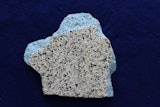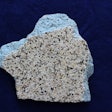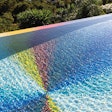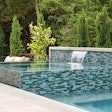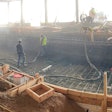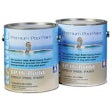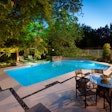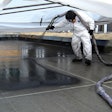
At the PSP Expo in Dallas in November, a new product for protecting and restoring plaster and concrete, Microglass, received a great deal of attention. Group discussions in front of its booth were almost constant throughout the exhibit hours as were casual conversations of the bright possibilities for improved plaster finishes if product claims prove true. As one prominent plaster industry veteran put it, “It’s sure getting a lot of buzz here. If it does what they say, that would be big.”
Alan Smith, president of Alan Smith Pools and past president of the National Plasterers Council, is CEO of Oxium Water Technologies, the company that makes Microglass. He has been using the liquid product extensively both on new finishes and as part of pool renovations on old, cracking, deteriorating plaster finishes.
It’s applied with a roller on dry plaster or concrete, and according to Smith, “the liquid penetrates up to 8 inches into the surface and turns the void spaces in the concrete into a hard ceramic that both strengthens the surface and minimizes chemical interactions with pool water. And it’s completely non-toxic and environmentally friendly.”
Industry veterans need no reminders about the surface issues such as etching, spalling, calcium nodules and color loss that can crop up in plaster pools. Smith asserts Microglass can prevent many of them.
Much of the interest at the show came from groups of builders looking to alleviate finish problems at start up. Ben Evans, president of American Pools in Orlando, uses the product in that application. He began testing Microglass over two years ago, and after examining the results for about a year, he started using it on all his concrete pools as part of the company’s standard procedure.
“It’s a game changer as far as what it does,” he says. “Normally, when you’re applying a finish material, you get a lot of dusting once you fill it with water. Once you do the acid wash and you fill the pool, the finish has a lot of cream that’s coming to the top that turns into dust, and that gets into the filter and causes a mess. This product just stops all of that dusting from happening. There’s no dusting at all.
“That’s one of the biggest product payoffs,” Evans adds — ongoing protection of the finish from the ravages of bad pool chemistry. “I don’t know how much experience you’ve had in Florida, but a lot of people down here don’t spend a lot of time firing up a pool. There’s just a lot of pools to build, and the chemicals don’t always go in correctly during startup. And then you have homeowners taking care of the water, and maybe it’s their first pool, and they have no clue what to do. So they put in a capful of acid when it needs a half gallon — these kinds of things happen all the time — and pretty soon the chemistry is off, which means trouble for a new finish.
“But when I’ve used this product, the finish doesn’t get calcified, doesn’t have the scaling, fading, any of that kind of stuff that happens on a pool that doesn’t have the right chemicals in it. Because even if you have aggressive water in the pool, after you apply this product, it can’t suck anything out of the finish.
“I’ve witnessed cases where we used the product before startup, and then four weeks down the road, we stopped by to check the chemistry on the pool, and it was a wreck — pH was way out of range, there’s no chlorine, everything is just way off. But the finish was fine. There was no deterioration, it didn’t have any fading or shading or any of that kind of stuff, which you definitely would get without it.”
Unfortunately, it often doesn’t matter who’s at fault for the aggressive water that’s caused a discolored finish, there’s going to be a warranty claim. “And that’s probably the majority of warranty problems here — at least for me anyway,” Evans says, “and that’s why I use this product, it has cut them out completely. I don’t get any of these finish warranty problems at all.”
Cutting warranty costs is a point of emphasis at American Pools, Evans says, as that takes money directly from the bottom line. “I think it’s easy for a construction company owner to lose track of warranty costs. It happens all the time in the home-building world — they close units, but their warranty costs are absolutely outrageous. But we try to watch that. Because I think it’s ridiculous to finish the pool, have it all completely cleaned up a hundred percent and it looks great, and then you end up paying for warranty work.”
DOWNSIDE: ADDING A DAY TO THE PROCESS
Evans says the biggest hurdle for any company adopting the product is that you’re adding another task, another step to the process. And as any construction company owner knows, every step takes time, labor, money and communication between workers.
American Pools uses one crew to plaster the pool, and another comes in the next day to apply the Microglass, with a quality control crew checking things to make sure everything has been done right, because you don’t want to apply the Microglass until you’re sure the walls are clean and ready.
The actual Microglass application process entails neutralizing the pool walls and floor with sodium bicarb, and then you pressure wash, dry the walls and the floor, and apply the product.
“A crew can do two a day if they have some drive time between them,” says Evans, “or three a day if they’re in the same area. (And it doesn’t rain, yada, yada, yada.) And yes, you’re adding an extra day to the fill. But to me, it’s worth all the time and money in the world to save me what it costs to go back out there and warranty the situation and everything that goes with that.
“I mean, that just makes all the difference. When the pool finish goes in and suddenly it’s cloudy or it looks bad, well, the customer is now really mad. But after that whole pool process, if they’re happy with the finish and everything else that goes in the pool, well, that’s what we’re aiming for. That’s where you get the referrals.”





















